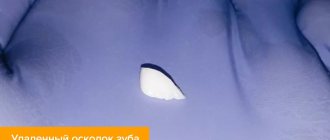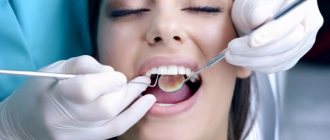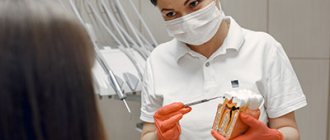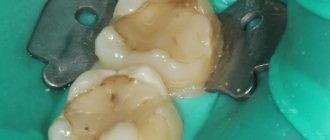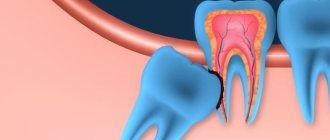Author: Brodsky Sergey Evgenievich Deputy Chief Physician, Candidate of Medical Sciences in the specialties: dentistry and medical microbiology A cyst on the root of a tooth under the crown is one of the fairly common and most dangerous dental diseases. Dentists consider it difficult to treat, and until recently such a diagnosis threatened to remove the tooth, but modern methods of dental treatment provide a fairly high chance of saving it.
Deputy chief physician
Brodsky Sergey Evgenievich
Sign up for a free consultation
+7
What is a tooth root cyst?
A cyst on a tooth under the crown is a benign neoplasm localized at the apex of the tooth root, in its bone tissue. The cystic structure has the appearance of a round cavity, covered from the inside with a fibrous membrane and filled with purulent exudate. First of all, a cyst under the crown of a tooth indicates that the treatment at the stage of preparation for prosthetics was carried out in bad faith, with poor-quality filling of the root canals.
Why does a dental cyst form?
The cause of cyst formation is an untreated root canal infection.
The reasons for infection in the root of a tooth can be different:
- As a complication of insufficiently treated or completely neglected
- caries/pulpitis,
- periodontitis,
- periodontal diseases,
- inflammation under the dental crown,
- Error and infection during endodontic treatment (root canal treatment).
- Tooth injury.
- Immune disorders in the body.
- Chronic diseases of the ENT organs: runny nose, sinusitis, tonsillitis.
Children in primary and mixed dentition can also suffer from dental cysts. Even newborns may experience teething with a purulent cyst - the so-called. Bona knots.
Types or types of neoplasms
| Type of cyst | Peculiarities |
| Radicular | Localized in the root area, it occurs as a result of insufficient treatment |
| Paradental | Occurs next to a wisdom tooth that has difficulty erupting |
| Residual | This is a formation that remains in the bone tissue of the jaw after tooth extraction. It can manifest itself, for example, after prosthetics with bridge structures |
On a note! Doctors also identify other types of cysts, but they no longer appear on teeth with prosthetic structures. For example, a follicular formation may appear when the buds of a baby or permanent tooth become infected. The primary cyst occurs against the background of complex eruption of individual units.
What are dental cysts?
Diagnostic measures
Here, the most effective diagnostic method to this day remains x-ray examination. After all, it is with the help of an image that the doctor can best assess the extent of the inflammatory process and confirm the diagnosis. In the photographs, the cyst appears as a black, rounded spot located near the apex of the root.
“Many patients panic, suspecting a cyst under the crown. After all, in their minds they immediately begin to replay a situation in which in any case they will have to get rid of the prosthetic structure, remove it, treat it, and then install a new one. All this costs significant costs, and no one wants to pay twice. It is important to emphasize here that the less the inflammatory process, the greater the chance of getting by with therapeutic measures, medications, and even in some cases you may not have to remove a previously installed crown. Therefore, it is important for patients not to delay treatment, but to immediately consult a doctor at the first suspicion. This is a real chance to save money and nerves,” says dentist-therapist O.A. Belyaeva.
Why do you need to remove the cyst?
If a dental cyst is not removed in time, even with an asymptomatic course of the disease, the consequences can be very serious - this is a real “time bomb”.
- The main danger of a cyst is that sooner or later it will destroy the affected tooth, and then “get” to the neighboring teeth.
- Cysts are reborn. Slowly but surely, so in 15-20 years it may already be a malignant formation.
- An infection is raging in the cavity of the cyst, so with a general illness, hypothermia, or a decrease in immunity as a result of simple stress, acute purulent inflammation is possible - flux, abscess, phlegmon.
- The infection can spread to adjacent lymph nodes and cause inflammation - lymphadenitis.
- Gradual thinning of the jaw bone in the affected area, due to purulent melting, turns into osteomyelitis. Even a spontaneous fracture of the jaw is possible.
- The cyst enlarges and can grow into the nasal cavity or maxillary sinus.
- Infection in the cyst can cause sepsis, a blood poisoning.
If treatment is not started on time, the tooth will have to be removed. And this is the minimum “evil”.
General overview
In dentistry, a cyst refers to benign neoplasms localized in the structure of mucous tissues located near the roots of the teeth. The capsule, formed from fibrous tissue, is filled with a liquid composition containing epithelial cells that have undergone necrotic changes, as well as dead bacteria. During development, the contents of the cyst are converted into a purulent mass.
For most cases, the main prerequisite for pathology is infectious infection. The body, seeking to counteract the disease, sends immune cells to the localized area, whose task is to contain the spread. At the same time, complete independent elimination of pathogenic microflora, without proper medical intervention, is almost impossible. Cystic formations are the result of severe damage and lead to a deterioration in the general condition of the patient.
What are the symptoms of a dental cyst?
For a long time, the cyst may not manifest itself in any way until it becomes large enough in size, so it is very rare that a cyst is diagnosed at an early stage of the disease. This mostly occurs accidentally when the patient is having an x-ray for another reason.
At a later stage, the patient begins to worry about:
- Aching pain that gets worse over time. Such pain is difficult to relieve with regular painkillers.
- Pain when biting.
- Swelling of the gums and/or cheeks.
- An abscess, gumboil, or fistula may form on the gum.
- General malaise, fever.
The relevance of traditional methods of treatment
You need to understand that the cyst is located deep under the crown - and none of the home or folk methods will help cope with it, but will only smooth out the manifestations a little. Those. the patient will feel a little better, but the pathology will not go away - it will continue to develop until complications begin. Therefore, the best option is to seek professional dental help. And the use, for example, of saline solution, tinctures of medicinal herbs, various natural oils, and alcohol tinctures is possible only with the permission of the dentist as an addition to the main treatment.
“The crown on the lower five began to wobble a little after 6 years of wearing it. I went to the dentist and thought about removing the tooth and placing an implant right away. But the doctor upset me that it was too early to think about it, because there was a large cyst under the root. I had to remove the tooth along with it anyway. Now I'm waiting for everything to heal. They said that it would take a few months for the bone to recover. In the meantime, I sometimes go for checkups so that there are no problems.”
Glorya_77, review from gidpozubam.ru
How is a dental cyst treated?
The first thing that should be said is that today a dental cyst is successfully treated with a high percentage of preservation of the affected tooth, although in the past the diagnosis of a “cyst” meant 100% removal.
There are 2 main approaches to treatment:
- Therapeutic. Therapeutic treatment of dental cysts is used when
- There is access to the dental canal through the dental crown
- The canals are not sealed or can be opened
This method of treatment is very similar to the treatment of periodontitis, with the only difference being that the doctor additionally removes pus from the cyst cavity and injects special medicinal preparations into the root canal.
This treatment takes at least 1-2 visits, is carried out under sterile conditions, using a rubber dam and a dental microscope, because requires special care from the doctor to prevent relapses.
Treatment of cysts with laser with access through the coronal part of the tooth is another type of therapeutic treatment. Its main difference is that the laser immediately completely disinfects the area of the removed cyst, the treatment is quick and bloodless, the disadvantages include the risk of burns.
There are several methods for surgical removal of cysts, but cystectomy - complete removal of the cyst with all its contents - is the most modern and most effective of them.
Cystectomy is indicated for:
- A sealed root canal that is difficult to open.
- The affected tooth is replaced with a crown
- Pain, swelling of the cheeks/gums.
Development factors
The main factor causing the development of the disease is infection of the jaw region. The body’s natural reaction to pathology is the activation of immune cells directed to the problem area and designed to contain the further spread of pathology. However, the system is not able to completely stop and neutralize pathogens; this requires medical intervention, the absence of which may lead to a deterioration in the patient’s health.
Negative prerequisites indicating a high probability of cyst formation also include granulomas - nodular areas that form against the background of bacteria entering the tissue structure. The transformation of granulomas into cysts is caused by a number of accompanying circumstances:
- Failure to comply with the protocol for installing replacement prostheses;
- Violation of the regulations for dental treatment of root canals;
- The development of dental pathologies occurring in a chronic form;
- Allergy that occurs as a result of filling the cavity with a composite composition;
- Injuries and damage to the gum structure;
- Complicated consequences caused by past infection;
- Pathological processes developing in the periodontal structure;
- Systematic neglect of hygiene standards.
Practice shows that in most cases, the formation of a cyst is a consequence of surgical installation of prostheses, which involves radical intervention in the tissue structure. Negative symptoms do not appear immediately; often the first signs of pathology are observed only several years after the operation.
How is surgery to remove a cyst (cystectomy) performed?
Removal of the cyst is carried out by a dental surgeon in a surgical office, on an outpatient basis, the operation usually lasts about half an hour, an hour after the manipulation the patient can go home. Improvement in the patient's condition should occur 6-8 hours after the operation. A sick leave certificate is issued for the recovery period - until the stitches are removed.
To relieve all pain, the patient is given local conduction or infiltration anesthesia; we also numb the injection site with an application gel. After surgery, painkillers in tablets are prescribed for the first time.
I Preparatory stage
- The patient is diagnosed by a surgeon, and a consultation with the attending dentist-therapist is required.
- It is advisable, if the operation is not urgent, to provide the patient with professional hygiene and sanitation of the oral cavity before surgery - this reduces the presence of infection in the oral cavity and healing proceeds faster.
II Carrying out the operation
- The patient is given anesthesia.
- The surgical field is treated with an antiseptic.
- The dentist-surgeon separates the mucoperiosteal flap from the bone.
- Access to the affected area is provided, the cyst along with the affected part of the apex of the tooth is removed.
- The cavity is thoroughly cleaned and washed with an antiseptic.
- An antiseptic is injected into the cavity and the wound is sutured.
- During the recovery process, the cavity heals on its own and the bone tissue is restored.
III Postoperative period
- After the operation, you should not eat for 4 hours, then the food should not be hot, liquid and gentle.
- The patient is prescribed antibiotics to fight the infection and painkillers.
- Hygiene can be carried out according to the standard scheme one day after surgery, according to the recommendations of your doctor.
- Antiseptic rinses and healing gels are prescribed.
- Swelling of the gums and face may occur for several days.
- NOT RECOMMENDED:
- Warm the surgical site, because re-development of the infection is possible.
- Take medications without a doctor's prescription.
Prevention of dental cysts
Taking standard care of your dental and general health will help prevent the development of cysts.
To prevent dental cysts from bothering you, you must:
- Undergo regular preventive examinations with your dentist every 6 months and a professional hygiene procedure. Do not refuse if the doctor offers you an X-ray examination - he has reasons for this.
- Treat caries and pulpitis in a timely manner.
- To identify hidden caries at an early stage of the disease, for this in our clinic we use digital (not x-ray) diagnostics using the Diagnocam apparatus. We recommend undergoing such diagnostics at least once every six months.
- Brush your teeth well yourself using dental floss, irrigator, and mouthwash. Pay attention to cleaning your tongue.
- Strengthen immunity.
Consequences and complications of the disease
Why is a tooth cyst under a crown dangerous? If the pathology is left unattended, then eventually even a slowly developing neoplasm will provoke any of the following complications:
- spread of inflammation to the roots of neighboring teeth: they may change color, begin to hurt, become loose or fall out,
- tooth loss,
- spread of pus to the jaw and soft tissues: this can result in osteomyelitis, abscess, phlegmon, sinusitis, etc.,
- spread of infection throughout the body through the bloodstream: can cause damage to the brain, lungs, liver, kidneys and other organs,
- “degeneration” into a malignant neoplasm,
- sepsis.
Treatment of consequences and complications is much more difficult, longer and more expensive than treatment of a cyst. In many cases, the patient will additionally require rehabilitation1, and, for example, jaw bone augmentation after osteomyelitis. By the way, with this disease you can lose all your teeth in a row.
Complex on 4 OSSTEM implants with delayed loading - from RUB 170,000.
Complex implantation Osstem (South Korea) with delayed loading after 4-6 months.
Guarantee for the doctor’s work - unlimited Call now or order a call
Opening hours: 24 hours a day - seven days a week






